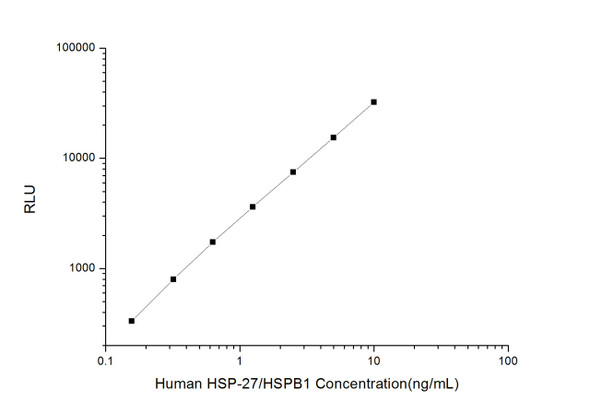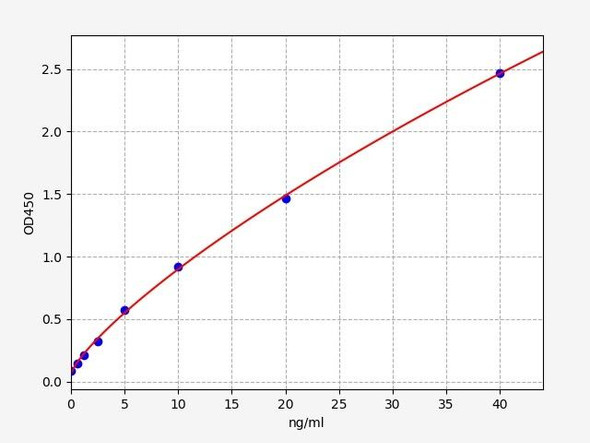Human Immunology ELISA Kits 2
Human HSP-27/HSPB1 (Heat Shock Protein 27) ELISA Kit (HUES02812)
- SKU:
- HUES02812
- Product Type:
- ELISA Kit
- Size:
- 96 Assays
- Uniprot:
- P04792
- Sensitivity:
- 0.47ng/mL
- Range:
- 0.78-50ng/mL
- ELISA Type:
- Sandwich
- Synonyms:
- HSPB1, CMT2F, HMN2B, HS.76067, HSP27, HSP28, Hsp25, SRP27
- Reactivity:
- Human
- Sample Type:
- Serum, plasma and other biological fluids
- Research Area:
- Immunology
Description
| Assay type: | Sandwich |
| Format: | 96T |
| Assay time: | 4.5h |
| Reactivity: | Human |
| Detection Method: | Colormetric |
| Detection Range: | 0.78-50 ng/mL |
| Sensitivity: | 0.47 ng/mL |
| Sample Volume Required Per Well: | 100µL |
| Sample Type: | Serum, plasma and other biological fluids |
| Specificity: | This kit recognizes Human HSP-27/HSPB1 in samples. No significant cross-reactivity or interference between Human HSP-27/HSPB1 and analogues was observed. |
This ELISA kit uses Sandwich-ELISA as the method. The micro ELISA plate provided in this kit has been pre-coated with an antibody specific to Human HSP-27/HSPB1. Standards or samples are added to the appropriate micro ELISA plate wells and combined with the specific antibody. Then a biotinylated detection antibody specific for Human HSP-27/HSPB1 and Avidin-Horseradish Peroxidase (HRP) conjugate are added to each micro plate well successively and incubated. Free components are washed away. The substrate solution is added to each well. Only those wells that contain Human HSP-27/HSPB1, biotinylated detection antibody and Avidin-HRP conjugate will appear blue in color. The enzyme-substrate reaction is terminated by adding Stop Solution and the color turns yellow. The optical density (OD) is measured spectrophotometrically at a wavelength of 450 nm ± 2 nm. The OD value is proportional to the concentration of Human HSP-27/HSPB1. The concentration of Human HSP-27/HSPB1 in samples can be calculated by comparing the OD of the samples to the standard curve.
| UniProt Protein Function: | HSP27: a small heat shock protein that is regulated both transcriptionally and posttranslationally. Modulates actin polymerization and reorganization. Its expression level increases several-fold in response to stress and is phosphorylated by MAPKAP kinase 2. Cytoplasmic in interphase cells. Colocalizes with mitotic spindles in mitotic cells. Translocates to the nucleus during heat shock. |
| UniProt Protein Details: | Protein type:Chaperone; Motility/polarity/chemotaxis; Heat shock protein Chromosomal Location of Human Ortholog: 7q11. 23 Cellular Component: proteasome complex; extracellular space; focal adhesion; cytoskeleton; cytoplasm; plasma membrane; spindle; Z disc; nucleus; cytosol Molecular Function:identical protein binding; protein kinase C inhibitor activity; protein binding; ubiquitin binding; protein kinase C binding; protein kinase binding Biological Process: positive regulation of interleukin-1 beta production; positive regulation of tumor necrosis factor biosynthetic process; retinal homeostasis; positive regulation of angiogenesis; response to virus; positive regulation of blood vessel endothelial cell migration; negative regulation of protein kinase activity; gene expression; vascular endothelial growth factor receptor signaling pathway; cell motility; regulation of I-kappaB kinase/NF-kappaB cascade; response to unfolded protein; negative regulation of apoptosis; regulation of translational initiation Disease: Neuronopathy, Distal Hereditary Motor, Type Iib; Charcot-marie-tooth Disease, Axonal, Type 2f |
| NCBI Summary: | The protein encoded by this gene is induced by environmental stress and developmental changes. The encoded protein is involved in stress resistance and actin organization and translocates from the cytoplasm to the nucleus upon stress induction. Defects in this gene are a cause of Charcot-Marie-Tooth disease type 2F (CMT2F) and distal hereditary motor neuropathy (dHMN). [provided by RefSeq, Oct 2008] |
| UniProt Code: | P04792 |
| NCBI GenInfo Identifier: | 19855073 |
| NCBI Gene ID: | 3315 |
| NCBI Accession: | P04792. 2 |
| UniProt Secondary Accession: | P04792,Q6FI47, Q96C20, Q96EI7, Q9UC31, Q9UC34, Q9UC35 Q9UC36, B2R4N8, |
| UniProt Related Accession: | P04792 |
| Molecular Weight: | 205 |
| NCBI Full Name: | Heat shock protein beta-1 |
| NCBI Synonym Full Names: | heat shock 27kDa protein 1 |
| NCBI Official Symbol: | HSPB1 |
| NCBI Official Synonym Symbols: | CMT2F; HMN2B; HSP27; HSP28; Hsp25; SRP27; HS. 76067; HEL-S-102 |
| NCBI Protein Information: | heat shock protein beta-1; HSP 27; 28 kDa heat shock protein; heat shock 27 kDa protein; heat shock 27kD protein 1; stress-responsive protein 27; estrogen-regulated 24 kDa protein; epididymis secretory protein Li 102 |
| UniProt Protein Name: | Heat shock protein beta-1 |
| UniProt Synonym Protein Names: | 28 kDa heat shock protein; Estrogen-regulated 24 kDa protein; Heat shock 27 kDa protein; HSP 27; Stress-responsive protein 27; SRP27 |
| Protein Family: | Heat shock protein |
| UniProt Gene Name: | HSPB1 |
| UniProt Entry Name: | HSPB1_HUMAN |
As the OD values of the standard curve may vary according to the conditions of the actual assay performance (e. g. operator, pipetting technique, washing technique or temperature effects), the operator should establish a standard curve for each test. Typical standard curve and data is provided below for reference only.
| Concentration (ng/mL) | O.D | Average | Corrected |
| 50 | 2.382 2.418 | 2.4 | 2.329 |
| 25 | 1.721 1.723 | 1.722 | 1.651 |
| 12.5 | 0.953 0.951 | 0.952 | 0.881 |
| 6.25 | 0.462 0.472 | 0.467 | 0.396 |
| 3.13 | 0.279 0.257 | 0.268 | 0.197 |
| 1.56 | 0.185 0.163 | 0.174 | 0.103 |
| 0.78 | 0.12 0.128 | 0.124 | 0.053 |
| 0 | 0.062 0.08 | 0.071 | -- |
Precision
Intra-assay Precision (Precision within an assay): 3 samples with low, mid range and high level Human HSP-27/HSPB1 were tested 20 times on one plate, respectively.
Inter-assay Precision (Precision between assays): 3 samples with low, mid range and high level Human HSP-27/HSPB1 were tested on 3 different plates, 20 replicates in each plate.
| Intra-assay Precision | Inter-assay Precision | |||||
| Sample | 1 | 2 | 3 | 1 | 2 | 3 |
| n | 20 | 20 | 20 | 20 | 20 | 20 |
| Mean (ng/mL) | 2.50 | 6.90 | 21.00 | 2.60 | 7.20 | 22.30 |
| Standard deviation | 0.20 | 0.30 | 1.00 | 0.20 | 0.30 | 1.00 |
| C V (%) | 8.00 | 4.35 | 4.76 | 7.69 | 4.17 | 4.48 |
Recovery
The recovery of Human HSP-27/HSPB1 spiked at three different levels in samples throughout the range of the assay was evaluated in various matrices.
| Sample Type | Range (%) | Average Recovery (%) |
| Serum (n=5) | 94-109 | 102 |
| EDTA plasma (n=5) | 87-98 | 92 |
| Cell culture media (n=5) | 83-95 | 90 |
Linearity
Samples were spiked with high concentrations of Human HSP-27/HSPB1 and diluted with Reference Standard & Sample Diluent to produce samples with values within the range of the assay.
| Serum (n=5) | EDTA plasma (n=5) | Cell culture media (n=5) | ||
| 1:2 | Range (%) | 91-108 | 97-112 | 86-100 |
| Average (%) | 99 | 103 | 92 | |
| 1:4 | Range (%) | 95-109 | 81-93 | 94-110 |
| Average (%) | 102 | 86 | 101 | |
| 1:8 | Range (%) | 94-107 | 81-93 | 93-106 |
| Average (%) | 101 | 87 | 100 | |
| 1:16 | Range (%) | 97-108 | 81-94 | 95-108 |
| Average (%) | 103 | 86 | 100 |
An unopened kit can be stored at 4°C for 1 month. If the kit is not used within 1 month, store the items separately according to the following conditions once the kit is received.
| Item | Specifications | Storage |
| Micro ELISA Plate(Dismountable) | 8 wells ×12 strips | -20°C, 6 months |
| Reference Standard | 2 vials | |
| Concentrated Biotinylated Detection Ab (100×) | 1 vial, 120 µL | |
| Concentrated HRP Conjugate (100×) | 1 vial, 120 µL | -20°C(shading light), 6 months |
| Reference Standard & Sample Diluent | 1 vial, 20 mL | 4°C, 6 months |
| Biotinylated Detection Ab Diluent | 1 vial, 14 mL | |
| HRP Conjugate Diluent | 1 vial, 14 mL | |
| Concentrated Wash Buffer (25×) | 1 vial, 30 mL | |
| Substrate Reagent | 1 vial, 10 mL | 4°C(shading light) |
| Stop Solution | 1 vial, 10 mL | 4°C |
| Plate Sealer | 5 pieces | |
| Product Description | 1 copy | |
| Certificate of Analysis | 1 copy |
- Set standard, test sample and control (zero) wells on the pre-coated plate and record theirpositions. It is recommended to measure each standard and sample in duplicate. Note: addall solutions to the bottom of the plate wells while avoiding contact with the well walls. Ensuresolutions do not foam when adding to the wells.
- Aliquot 100µl of standard solutions into the standard wells.
- Add 100µl of Sample / Standard dilution buffer into the control (zero) well.
- Add 100µl of properly diluted sample (serum, plasma, tissue homogenates and otherbiological fluids) into test sample wells.
- Cover the plate with the sealer provided in the kit and incubate for 90 min at 37°C.
- Aspirate the liquid from each well, do not wash. Immediately add 100µL of BiotinylatedDetection Ab working solution to each well. Cover the plate with a plate seal and gently mix. Incubate for 1 hour at 37°C.
- Aspirate or decant the solution from the plate and add 350µL of wash buffer to each welland incubate for 1-2 minutes at room temperature. Aspirate the solution from each well andclap the plate on absorbent filter paper to dry. Repeat this process 3 times. Note: a microplatewasher can be used in this step and other wash steps.
- Add 100µL of HRP Conjugate working solution to each well. Cover with a plate seal andincubate for 30 min at 37°C.
- Aspirate or decant the solution from each well. Repeat the wash process for five times asconducted in step 7.
- Add 90µL of Substrate Reagent to each well. Cover with a new plate seal and incubate forapproximately 15 min at 37°C. Protect the plate from light. Note: the reaction time can beshortened or extended according to the actual color change, but not by more than 30min.
- Add 50 µL of Stop Solution to each well. Note: Adding the stop solution should be done inthe same order as the substrate solution.
- Determine the optical density (OD value) of each well immediately with a microplate readerset at 450 nm.






